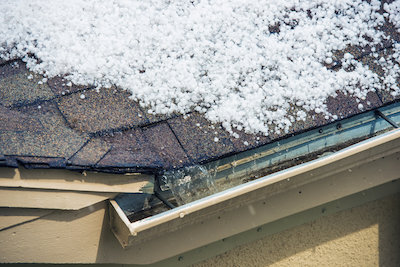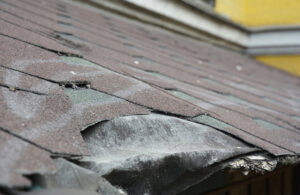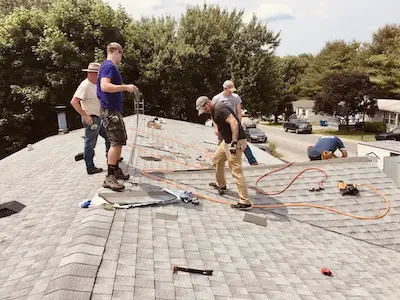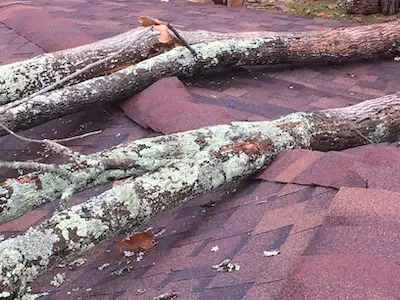Most Likely Reasons Your Roof is Sagging
Noticing a sag in your roof can be worrying. A little bit of sagging doesn’t necessarily mean your roof is in danger of collapsing, however, it does mean you should act quickly to make sure there aren’t any bigger issues lurking. There are various reasons why your roof may be sagging, but the good news is, most can be fixed simply by reinforcing and/or repairing the damage. Keep reading to see why your roof may be sagging and how you can fix it.
Why is my roof sagging? Some of the reasons why your roof may be sagging include:
- Excessive Weight
- Roof Damage
- Water Damage
- Poor Quality Materials and Design Flaws
Once you notice the problem, it’s important to call a roofing professional right away so you can determine the cause and fix it before anything serious happens. Now let’s discover how these issues create a sagging roof and the methods you can use to repair it.

Excessive Weight on the Roof
Roofs are designed to support a specific amount of weight. They will be built with the environment and weather conditions of the area in mind so that they can withstand the normal weather patterns. The main purpose of a roof is to keep things out of the house and provide shelter over your head.
In the winter months, if heavy snow or ice falls and stays on the roof for a long period of time, it can cause damage and sag. Unfortunately, there’s not much you can do to prevent snow and ice from falling on your house, but you can have it removed quickly to limit the damage.
When snow falls, it can be surprisingly heavy. The added weight can put stress on your roof, especially if it sticks for long periods of time. Once the snow melts, you may notice that your roof looks worn or has some weak spots. Fixing this problem may include repairing the weak areas or adding some supportive bracing to the attic under the roofline.
We can’t control the weather, so the best thing you can do is have a professional come out and clean your roof as soon as it’s safe to do so. Professionals will come out and be able to blow and shovel the snow off your roof and remove the extra weight.
 Roof Damage
Roof Damage
Roof damage, unfortunately, comes in many different forms. Weather, environment, animals, etc. can all have an impact on the strength and health of your roof. Once the roof has been weakened, it is much more likely to begin sagging and potentially causing other problems.
Whether your house sits under old trees where the branches rest or fall on the roof, or is host to a family of squirrels and other animals – damage is possible. The problem with roof damage is that it isn’t always visible or noticeable. Unless your roof is just extremely old or the damage has to do with a tree falling through it, you may not realize there’s a problem.
If you happen to fall under the category of noticeable roof damage, i.e. holes and leaks, then the best thing you can do is call a roofing expert. Hopefully, there are only a few weak spots and you don’t need to replace the whole roof.
Unfortunately, if the damage is not noticeable, you may not realize the extent of the damage until the sagging appears – at which point, it’s time to call a professional roofing company. Be careful when checking out the roof, too many accidents happen when people fall off ladders. Leave it to the experts.
Water Damage
Water damage is two dreaded words that no homeowner wants to hear. Whether it’s inside the home or up on the roof, water can cause a lot of problems and be extremely costly to repair. If you notice your roof sagging, there’s a good chance it could be because of water damage.
A lot of rain in a short amount of time or weathered shingles from rain and weather exposure over long periods of time can both cause your roof to weaken significantly. Improper drainage from the gutter system can also create a sagging effect that will impact the strength of your roof.
One other possibility of water damage impacting your roof may be poor ventilation in the attic. When attics aren’t able to filter out excess moisture in the air via a vent, the water can absorb into the wood and cause water buildup under the surface of the roof.
The best way to fix water damage on your roof is to fix each area of your problem. Clear out and fix the gutter drainage system, create a better ventilation system in your attic, and re-shingle/weather-proof your roof. There’s not much you can do about exposure to weather, but reinforcing the existing structures is a good start at improving the strength of your roof.
Poor Quality Materials & Design Flaws
Even though houses undergo inspections during the buying and selling process, sometimes things get missed. Things like design flaws and builders using poor quality materials. Poor quality materials are one thing – maybe the builder was trying to save money, and design flaws are another.
You can’t always blame a builder and accuse them of ripping you off, sometimes they are limited in what they can do, and lower quality materials are the result. Whether they were trying to save money or time, it does happen. To fix this, you simply need to have a professional come in and replace or add support to the areas where it’s needed.
Design flaws that could cause the sagging in your roof may include undersized rafters, too few rafters, and/or insufficient sheathing. Luckily, these issues aren’t as complex to fix. However, it can still be frustrating to have to pay to fix something that should have never been broken in the first place. A professional will come out and shore up the support by adding rafters and support beams and replacing the sheathing.
 What Will it Cost to Fix a Sagging Roof?
What Will it Cost to Fix a Sagging Roof?
The two possible scenarios for someone to pay for repairs on a sagging roof:
- Homeowner pays out of pocket for repair or complete replacement cost.
- Homeowner pays insurance deductible and Insurance covers repairs or replacement over the deductible amount.
How Much Does it Cost to Repair a Sagging Roof?
Unfortunately, repairing a sagging roof is one of the more costly roof issues to fix. Depending on the severity of the problem, you could be looking to spend anywhere from $750 to $3,000 or up to $10,000+ for a whole new roof.
All of the repairs will depend on the damage, the size of the roof needing the repair, the materials needed to fix it, and the company you choose to go with. If you’re needing to replace the whole roof, the type of material you choose can heavily impact the price. On a smaller repair, doing quality work will ensure that any problems in the future will be limited and you won’t have to shell out a bunch of money at once.
Does Insurance Cover a Sagging Roof?
Generally, most insurance companies cover damaged roofs, only if the damage was unpreventable. Things like storms, vandalism, trees falling, fire, etc. are considered to be unpreventable damages.
Insurance is often tricky and frustrating to work with. It is known that the insurance companies will help with repair costs, but often only in the affected areas. This means that if there is a heavily damaged part of your roof, insurance will help cover the cost of repairs. But, if the rest of the roof requires an upgrade, but has less damage than that one affected area, insurance will not cover the whole roof.
The best way to find out if you are covered is to contact your insurance agency about the specifics of your home insurance policy.
Related Questions
Is a sagging roof a problem? Sagging roofs can be a major problem for homes, especially if they haven’t been replaced in a long time. The structure of these aging roofs is often too weak to handle the weight from rain or snow melt on top. A great way to prevent further damage to the interior of the house would be to repair or replace the roof.
Should a new roof sag? No, but it can happen when installing new shingles over old ones. When you install a new roof, the decision between installing it over or pulling up old shingles can be difficult. Installing new ones on top of a worn out layer will weaken its structure and cause more issues down the road. The roof will begin to sag with weight from snow loads, wind gusts and heavy rain. While the top layer of shingles may be new, the old layer of shingles and decking may be damaged. It’s always better to remove old shingles and install new ones directly on the decking.

